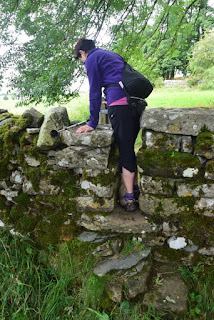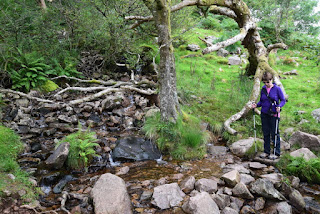We decided to spend the two or so weeks we had available
for travel in the ‘van in SE England. Near to our site in
Maidstone was Leeds Castle which claims to be the prettiest in England. Quite a
claim but it is very picturesque with its moat and streams. The first structure
dates back to a Saxon Manor as recorded in the Doomsday book of 1086.
The bridge to the castle is part of the Barbican which
was built to protect the water supply to the moat and watermill.
The moat is wide and would have been difficult to cross in an
attack, however the castle was never rarely used as a defence and was only
besieged twice when the resident offended the King (1139 and 1321).
One of the outbuildings was set in a beautifully
tranquil garden.
The castle entrance grabbed our attention but unfortunately the
barrels were all empty!
As we walked around they were sealing off various rooms
in preparation for a wedding – a pretty expensive affair I suspect.
The last owner of the house Lady Baillie
(1974) used the premises as one of her three homes. Her dressing case was made
from silk, crocodile skin, gold and a new plastic (Bakelite?). I am told I
should appreciate how light Helen travels. The castle is now part of a Trust
set up by Lady Baillie.
Some of the fittings seemed be a little less practical
than others. I suspect this may be an umbrella stand rather than a waste paper
basket.
Nearby to the caravan park was Bearsted Woodlands. This
was a lovely walking area developed by the local community with numerous young
trees dedicated to various family members. One 300 year old oak tree (in the
background) had fallen but rather than being removed was used as a climbing
frame and for various owl carvings.
As well as a rabbit and a badger.
Sue and Martin were berthed in London and came by
train to stay for a couple of days and explore this neck of the woods. Canterbury
a mere 20 minutes away was our first port of call. We had all visited the
cathedral in the past when entry was free it is now £15 so a second visit did not seem
to represent value. The tower looks better from afar in any case.
We did a circuit of the streets around the cathedral
where there were many historic sites. This pub built in 1503 was frequented by
Charles Dickens.
As was this one which had a distinct lean. This appears
to have stabilised since Charles D time when, in 1849, he wrote “… a very old house bulging
out over the road … leaning forward, trying to see who was passing on the narrow
pavement below….”
The river Stour passes through the city where you can
be rowed or punted along quite a fast flowing course. Or you can continue
discussions alongside the face sculpture outside the Marlow theatre.
The Roman wall around Canterbury was built in AD 270 –
290. Near the Eastern Queningate were statues of Ethelbert King of Kent and Bertha
his Queen (597 AD). They stand outside St Augustine's which is part of the Kings
School Canterbury.
There are many listed heritage buildings in Kent. We went to
Sissinghurst where were greeted by Oast houses, drying hay (without a combine harvester) and a tower.
The tower enabled remarkable view over the gardens
which were formally laid out but informally planted.
At the bottom of the garden was a reflective moat with a wall
separating the orchard from immaculate lawns. The timing of Martin’s entrance
was also immaculate arriving just as the crowds had dispersed.
We also visited Ightham Mote, a 14th Century
moated manor house. Although wonderfully attractive on a bright sunny day, it is
in a valley and was recovering from a flash flood in June. A number of
rooms were out of bounds with fans working 24 hours to circulate air and help the
drying process.
Some of the rooms had quirky ideas. This alcove was square
on one side and raked on the other.
Upstream the gardens included a calming lake
and the most twisted tree I have ever seen.
As many of you know Kent is an old haunt where I spent
most of my teenage years, so it was appropriate to have a small trip down
memory lane. I suspect this will appeal to only a small number of readers – so feel
free to skip this bit…
Helen and I started our married life in a brand new old
persons flat in Chatham. It is the top floor shown here. We furnished it with a
bean bag (we cooked the beans in a pan), a table I built and a water bed on the
floor as we could not afford a base. The flat does not look to have been
maintained since it was constructed in ’73! I do recall emptying the water bed
using a hose which was taken through the window and I held in the street. I did
get told off by one passer by for peeing in the street. I am not sure mentioning
water beds did anything to help his comprehension.
When I was 10 our family lived in a little village
called St Nicholas-at-Wade which used to overlook fields all the way to the sea
some 7 miles away. The fields are now used for agisting horses. I do recall
being snowed in here in ’63 (when the sea froze), but the weather for our visit was perfect.
As I got in with a questionable crowd we moved to a more pleasant town called Birchington right on the coast. The house was called Aston. Not much has changed here in 50 years.
As I got in with a questionable crowd we moved to a more pleasant town called Birchington right on the coast. The house was called Aston. Not much has changed here in 50 years.
There is still the walk down to the “beach” which used
to be a bit of a ramp however, there is now a large promenade and sea wall in both
directions.
We would have had a walk but as there was not a loo
within sight we moved on……
I have to say that Sue and Martin were very tolerant of
this part of the day and at some stages even feigned enthusiasm…

As we headed to Margate we had to snap this house which
a best man in the USA will recognise and is where I parked my bike while
working as a caddy on the adjacent Westgate golf course. The start of an
addiction.
Margate was always a bit of a dive and somewhere locals
travelled through rather than stopping. However, it is now looking quite
attractive and on the left of this view is the new “Turner Contemporary”
gallery. Quite an interesting construction into the sea.
As we continued around the coast we called into
Broadstairs. The constant breeze has not just worn out the flag but also
impacted this boat shed.
A little further on was Ramsgate and my high school
Chatham House unfortunately hidden by scaffolding.
A real shock to my system is that the school has now
been combined with Clarendon House (which is where sister Leslie went) and the
two are now led by a female Head Teacher. What is the world coming to?






















































































